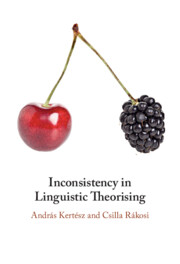Book contents
- Inconsistency in Linguistic Theorising
- Inconsistency in Linguistic Theorising
- Copyright page
- Dedication
- Contents
- Figures
- Tables
- Preface
- Abbreviations and central terms
- 1 Introduction
- Part I The State of the Art
- Part II Paraconsistency
- Part III Plausible Argumentation
- 6 From Paraconsistency to Plausible Argumentation
- 7 Inconsistency and Theory Change
- 8 The Treatment of Inconsistency in Optimality Theory
- 9 The Heuristics of Inconsistency Resolution
- Part IV Summary
- References
- Index
9 - The Heuristics of Inconsistency Resolution
from Part III - Plausible Argumentation
Published online by Cambridge University Press: 23 June 2022
- Inconsistency in Linguistic Theorising
- Inconsistency in Linguistic Theorising
- Copyright page
- Dedication
- Contents
- Figures
- Tables
- Preface
- Abbreviations and central terms
- 1 Introduction
- Part I The State of the Art
- Part II Paraconsistency
- Part III Plausible Argumentation
- 6 From Paraconsistency to Plausible Argumentation
- 7 Inconsistency and Theory Change
- 8 The Treatment of Inconsistency in Optimality Theory
- 9 The Heuristics of Inconsistency Resolution
- Part IV Summary
- References
- Index
Summary
The present chapter strives to elaborate simple heuristics that might further the elaboration of p-solutions or p-resolutions of p-inconsistencies. We will take Moravcsik’s () typology of the treatment of conflicts as our starting point and we will attempt to integrate it into the p-model. After the brief Introduction (), inwe will present the examples given in Moravcsik (). Starting from her analyses, we will re-analyse the examples with the help of the p-model’s categories and will provide a new approach to the resolution strategies. Finally, in , we will summarise the main components of the heuristics we have revealed.
- Type
- Chapter
- Information
- Inconsistency in Linguistic Theorising , pp. 267 - 290Publisher: Cambridge University PressPrint publication year: 2022

